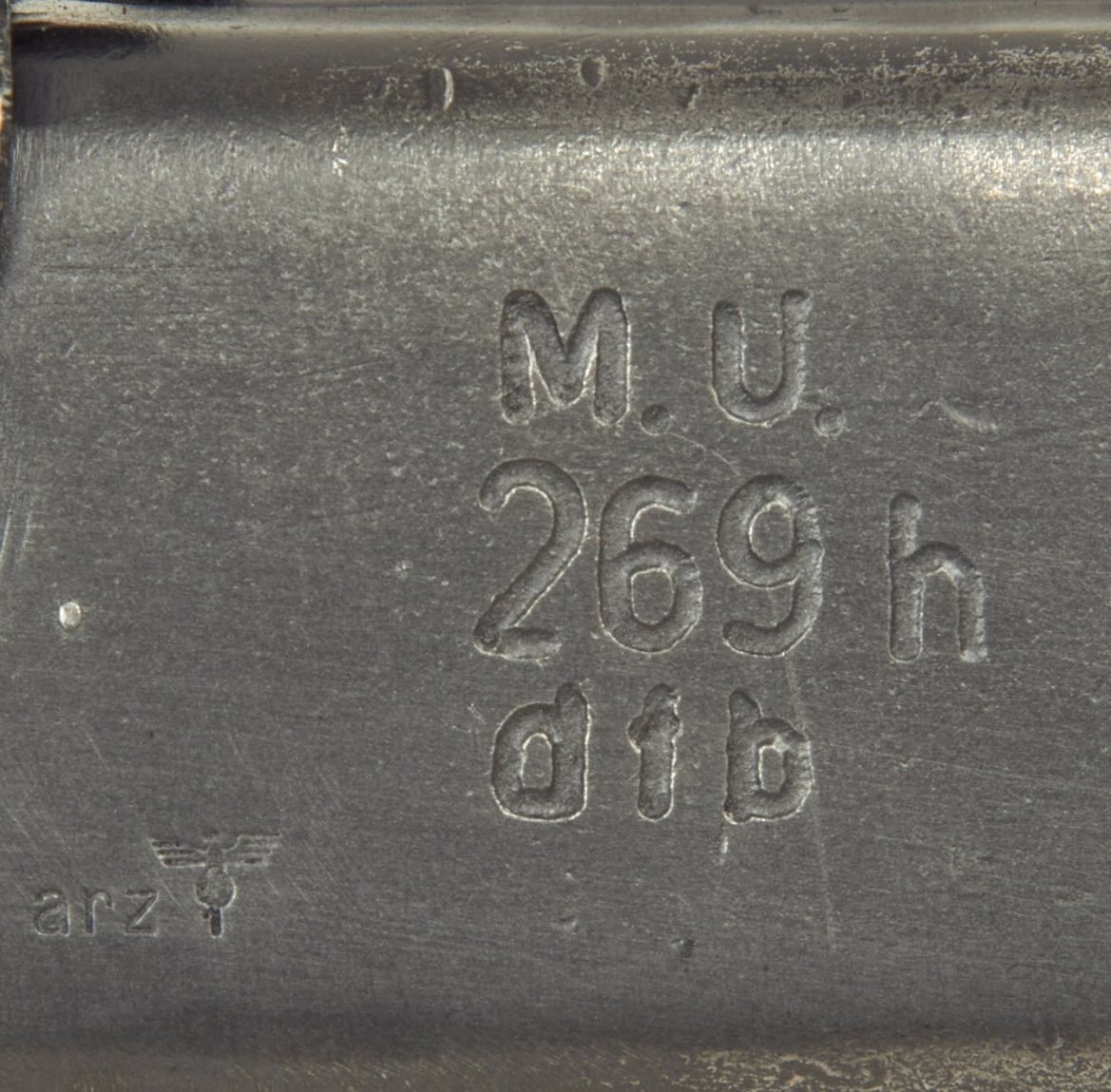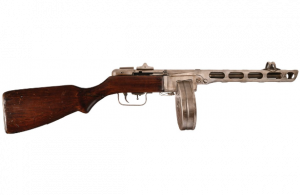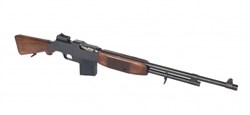Original Item: Only One Available. Constructed from a legally demilitarized (de-milled) parts set, this is a wonderful and rare German WWII MG42 Display Gun. Condition-wise, it is one of the best we have seen in years, and doesn’t have lots of crossed out markings as so many do. The metal finish and overall condition is excellent, and it will make a fantastic addition to any WWII Collection.
Comprised mostly of original WWII parts, this display gun was reconstructed using a BATF approved receiver with 2 inches totally replaced with solid bar stock, making this an inert non-firing display gun. Comes complete with German WWII issue parts including a wooden butt-stock, bipod, and a post-war repainted drum belt carrier which has been repainted with our panzergrau spray paint. This example even has a fully functioning barrel change assembly! Please note that the barrel must be in the forward position for it to open.
The rebuilt inert non-firing BATF approved receiver with a solid steel new made section has fine markings on the end that are easily visible and read-
M. U.
269 h
dfb
“dfb” is the maker code for Gustloff-Werke, Waffenfabrik, in Suhl, Germany. This company had originally been known as Gebrüder Simson(Simson Brothers) and
With the family now exiled from their own factory, the company was then forcibly renamed Berlin Suhler Waffen- und Fahrzeugwerke (Berlin Suhl Weapons and Vehicle works or BSW) and pressed into service making small arms, beginning with the MG 13 machine gun. Thankfully, the Simson family was able to emigrate to the U.S.A. in 1936.
In 1939, the factory was renamed to Gustloff-Werke – Waffenwerk Suhl, named after assassinated Swiss NSDAP member Wilhelm Gustloff. This company would continue manufacturing MG 34 and MG 42 machine guns under German three letter code “dfb”.
The date code M.U. with this maker mark indicates 1944 production, in the middle of MG 42 production. The top of the rear receiver is marked with three Waffenamt WaA4 markings, the correct inspector marking for this maker. There is also arz next to an Eagle / 1 proof, indicating that the receiver was made by subcontractor Deutsche Kühl- und Kraftmaschinen GmbH, who supplied the receivers to Gustloff-Werke, Mauser, and others.
The top cover and top cover latch both marked cof for Carl Eickhorn of Solingen, a legendary manufacturer of edged weapons, and a known make of top covers and other MG 42 components. There are also Waffenamt WaA519 proofs on the top cover, correct for Carl Eickhorn. The feed tray is marked with bpr, for Johannes Grossfuss of Dölbeln in Sachsen, a known maker of feed trays and top covers for both the MG 34 and 42.
The trigger group is Waffenamt Eagle / 147 marked next to a PJ maker mark. The top of the barrel trunion “camming block” by the barrel door is marked kls, for manufacture by Steyr-Daimler-Puch AG, Warsaw plant, Poland. Next to this is an Waffenamt Eagle / 189, the correct inspector mark for the Steyr Warsaw plant. The bipod is the correct type and is in great shape, though it has had the original wartime markings removed, and a post war marking added on the central portion by the height adjustment. The butt stock is wood, and is faintly marked with serial number 8987 on the left side. This display gun bears additional markings on various components.
Offered in excellent condition this is a very hard to find all German WWII mg42 Display Machine Gun. We only get these a few times a year, if we are lucky, so act quickly as they never last long.
Note: as these were in service post war, some components may display Yugoslav stock markings in addition to German wartime markings.
The MG 42 (shortened from German: Maschinengewehr 42, or “machine gun 42”) is a 7.92×57mm Mauser general purpose machine gun designed in NSDAP Germany and used extensively by the Wehrmacht and the Waffen-SS during the second half of World War II. It was intended to replace the earlier MG 34, which was more expensive and took much longer to produce, but in the event, both weapons were produced until the end of the war.
The MG 42 has a proven record of reliability, durability, simplicity, and ease of operation, but is most notable for its ability to produce a high volume of suppressive fire. The MG 42 had one of the highest average cyclic rates of any single-barreled man-portable machine gun: between 1,200 and 1,500 rpm, resulting in a distinctive muzzle report. The only Allied automatic ordnance of any type with a similar calibre that was designed to exceed this rate of fire was the Soviet Union’s .30-calibre ShKAS machine gun for aircraft armament, due to its “squirrel-cage” layout, ten-round “pre-feed” mechanism giving it a firing rate of 1,800 rounds per minute.
One of the weapon’s most notable features was in its exceptionally high rate of fire of about 1,200 rounds per minute, twice the rate of the Vickers and Browning machine guns, which fired at a rate of about 600 rounds per minute. So effective was the weapon in laying suppressive fire that the United States Army created training films to aid its soldiers in dealing with the psychological trauma of facing the weapon in battle. The MG 42 fired at such a high rate the human ear could not easily discern the sound of individual shots being fired, instead hearing a sound described as like “ripping cloth” or a buzzsaw, giving rise to the nickname “AH’s buzzsaw” (and the German soldiers’ AHsäge (“AH’s saw” or “bonesaw”).
The gun was sometimes called “Spandau” by British troops, as was the MG 34, a traditional generic term for all German machine guns, left over from the famous Allied nickname for the MG 08 Maxim-derivative used by German forces during WWI, which was derived from its manufacturer’s plates noting the city where some were produced.[citation needed]
The MG 42’s high rate of fire resulted from analysis concluding that since a soldier typically only has a short period of time to shoot at an enemy soldier, and muzzle rise quickly throws off initial aim, it was imperative to fire the highest number of bullets possible in the shortest time to increase the likelihood of a hit before the recoil overcame the inertia of the gun and pushed the aiming point upwards. The disadvantage was that the weapon consumed exorbitant amounts of ammunition and quickly overheated its barrel, making sustained fire problematic. Thus, while individual bursts left the weapon as highly concentrated fire at 1,200 rounds per minute, the Handbook of the German Army (1940) forbade the firing of more than 250 rounds in a single burst and indicated a sustained rate of no more than 300-350 rounds per minute to minimize barrel wear and overheating, although the excellent quick-change barrel design helped a great deal. Burst limits are typical on non-water-cooled automatic weapons, and slower-firing Allied guns such as the M1919 also had limits; they fired at a slower rate, but lacked a quick-change barrel, and so the operator had to limit his fire to a few hundred rounds per minute to allow the barrel to cool between bursts. Due to the slower firing rate, this led to a longer period of time spent shooting, but a roughly equivalent total number of rounds fired. Operationally, the MG 42’s main drawback was that it could consume ammunition at such a high rate that it was very difficult to keep firing during offensive actions, because ammunition had to be carried forward on a continuous basis. This was also a problem at the end of the war with inexperienced German troops. Good fire discipline was necessary, and the level of training that the German infantry was receiving at that time was poor.
The method of barrel change made the MG 42 unsuitable for secondary or co-axial armament on World War II era German tanks with the exception of the Jagdpanzer IV. Early versions of the Jagdpanzer IV carried two standard (no modification made) MG 42s on both sides of the gun mantlet/glacis, firing through a ball slot which was protected by an armored cover (with the MG 42 retracted) when not in use. Later version Jagdpanzer IVs carried only one MG 42 on the left side.
In the German heavy machine gun (HMG) platoons, each platoon served four MG 34/MG 42 machine guns, used in the sustained fire mode mounted on tripods. In 1944 this was altered to six machine guns in three sections with two seven-man heavy machine gun squads per section as follows:
Squad leader (NCO) MP40
Machine gunner (private) MG 34/MG 42 and pistol
Assistant gunner (private) pistol
Three riflemen (privates) rifles
Horse leader for horse, cart and trailer (private) rifle
The MG-42 incorporated lessons hard-won on the Eastern Front. Both the cocking handle and the catch for the top cover to the working parts were designed so that the gunner could operate them wearing mitts or with a stick or rod. This was vital for winter conditions where contact by bare flesh on cold metal could cause severe injury, such as instant frostbite.
The MG42’s effect was so devastating that Allied troops were trained before the D Day landings to distinguish its unique sound when fired, which was like cloth being ripped or the sound of a buzzsaw. Allied troops were trained to charge an MG-42-equipped pill box only at the time of its one weakness, which was when its overheating barrel needed to be changed.







Reviews
There are no reviews yet.